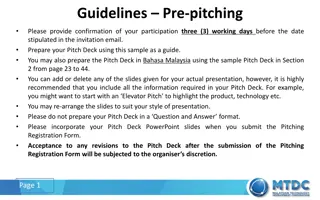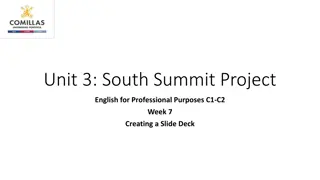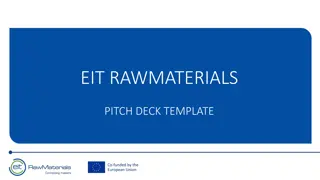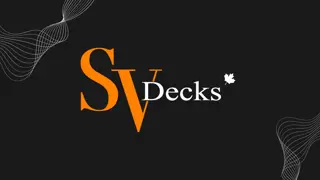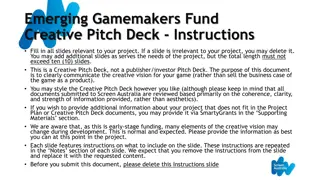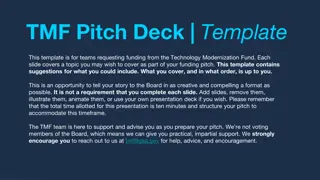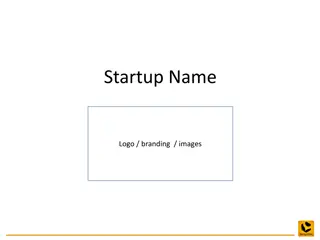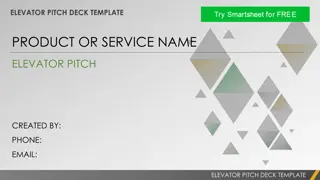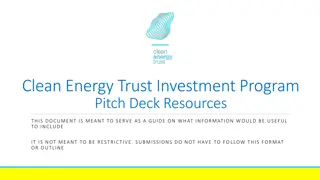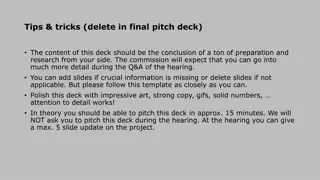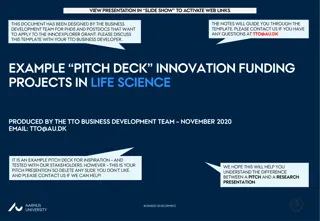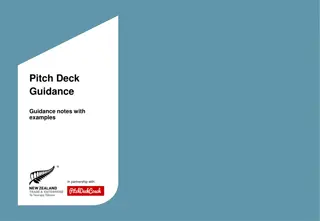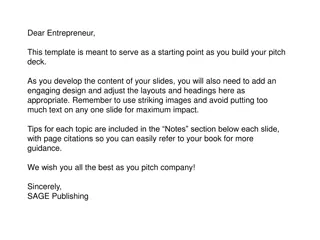
Crafting a Winning Pitch Deck
Craft a compelling pitch deck that encapsulates the essence of your venture, focusing on impact, growth potential, viability, and team execution capabilities. Learn how to structure your deck effectively with key elements such as problem, solution, market analysis, and competitive landscape to captivate investors and stakeholders.
Download Presentation

Please find below an Image/Link to download the presentation.
The content on the website is provided AS IS for your information and personal use only. It may not be sold, licensed, or shared on other websites without obtaining consent from the author. If you encounter any issues during the download, it is possible that the publisher has removed the file from their server.
You are allowed to download the files provided on this website for personal or commercial use, subject to the condition that they are used lawfully. All files are the property of their respective owners.
The content on the website is provided AS IS for your information and personal use only. It may not be sold, licensed, or shared on other websites without obtaining consent from the author.
E N D
Presentation Transcript
GOAL The goal of your pitch deck is to give a snapshot of your venture, taking into consideration your impact, growth potential, viability, and the ability of your team to execute your plan. Think of this as the most compelling elements of your executive summary presented visually and verbally.
Housekeeping Keep in mind that you will be allotted 10 minutes or less to present and may need to adjust the content and number of slides accordingly. Ensure slides are not text or data heavy and use at least a 30pt font.
Cover page TAGLINE: Define your venture with a short declarative sentence, getting to the heart of your venture s unique advantage. DATE: PRESENTER NAME:
Problem The goal is to get everyone nodding and buying in. - Guy Kawasaki, The Art of the Start Describe the pain of the customer (or the customer s customer) Outline how the customer addresses the issue today and why current solutions don t work. Is it costing the customer time, money, frustration Define the pain point. ($ amount, time lost, etc.)
Solution Demonstrate your company s value proposition to make the customer s life better Provide cases, customer insights, case studies Show scalability
Market Size/Dynamic Good analysis will therefore involve careful segmentation of the true addressable market and thoughtful descriptions of how those customers will pay for the solution over time to build up a picture of a realistic market size. - Michael Skok Identify/profile the customer you cater to Provide bottom-up market sizing: the number of potential customers and the price of the product sold into those customers. * The government census data is a good resource for this analysis. Changing trends, new technologies, and forces driving this segment
Competition Give a list of direct competitors, substitutes, or those about to emerge Why hasn t anyone done this before? What are the barriers to entry that keep someone from doing this and/or what would keep a competitor from imitating your product or entering your market? Highlight your venture s competitive advantages
Go-to-Market Strategy Tip: What are you selling? Who are you selling it to? How will you reach your target market? Where will you promote your product? What is your plan for execution? Summarize sales, marketing, and partnership plans
Product Product line-up (form factor, functionality, features, architecture, intellectual property) Development roadmap
Business Model Explain how you make money who pays you, your channels of distribution, and your gross margins. - Guy Kawasaki, The Art of the Start Revenue model Pricing Average account size and/or lifetime value Sales & distribution model Customer/pipeline list
Unit Economics Tip: Define key assumptions and drivers so it s clear that you ve developed a realistic model. CAC, LTV, LTV:CAC for first year ARR Gross margins
Key Milestones Outline current milestones achieved and future milestones. Customer research MVP development Product launch Beta users Market testing Marketing role out/CAC
Fundraising Tip: How much capital will you need prior to becoming cash flow positive and how will your funds be applied? You need to explain the minimum required equity you need to reach your next key milestone. Customer research- focus groups, surveys MVP development Product launch Go-to-market execution Other?
Team Tip: You need to convey that you are the team to execute this venture! Founders & Management What key skills or experience that relate to the product or leading of the company Board of Directors/Board of Advisors Highlight spheres of influence
Appendix Additional slides that can be used for follow-up questions.


